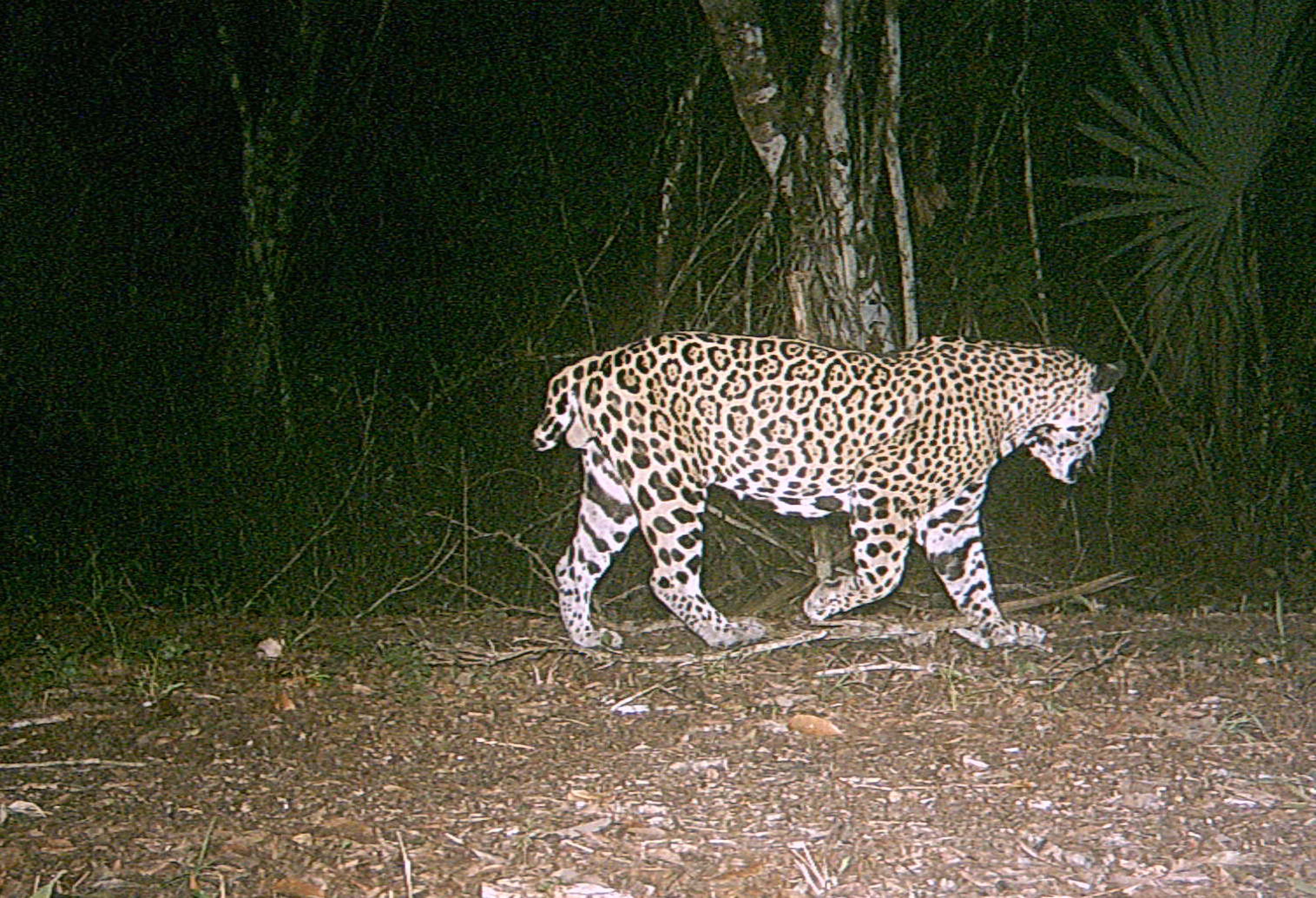- A jaguar nicknamed “Short-Tail” was caught on camera in both Belize and Guatemala, making him the first individual confirmed to cross the international boundary between the two countries.
- This finding highlights the importance of international, transboundary collaboration to study and protect jaguars.
- Jaguars are threatened by habitat loss, deforestation, loss of prey, and illegal hunting.
An adult male jaguar nicknamed “Short-Tail” (due to his partially missing tail) was caught on camera in both Belize and Guatemala, making him the first individual confirmed to cross the international boundary between the two countries.
Wildlife Conservation Society (WCS) scientists published their observation in CATnews, the newsletter of the Cat Specialist Group, a component of the Species Survival Commission of the IUCN. The researchers say this finding highlights the importance of international, transboundary collaboration to study and protect jaguars.

Jaguars (Panthera onca) are listed as near threatened on the IUCN Red List. According to the big cat conservation NGO Panthera, the species may be elevated to “vulnerable” in the coming year.
Jaguars are threatened by habitat loss, deforestation, loss of prey, and illegal hunting. Driven by demand in China, jaguars’ fangs, claws, heads and genitals are trafficked for use in traditional Chinese medicine and as ornaments. Ayahuasca tourism drives some trafficking of jaguar parts in South America.

Short-Tail was first photographed in Belize in 2009 with his whole tail and then with most of it missing (for unknown reasons) in 2011. He was caught on camera trap in Guatemala in 2013 and then returned to Belize in 2014. But it wasn’t until a conference in 2018 that researchers realized this was the same animal, and the first recorded transboundary jaguar in the region.

“We were surprised and delighted when we saw that ‘Short-Tail’ was photographed by other researchers,” Rony García-Anleu of WCS’s Guatemala program and the paper’s lead author, said in a statement. “This highlights the importance and potential for collaborative work between Belize and Guatemala and across the Maya Forest region.”
The Maya Forest spans from Colombia to Mexico, covering an area three times the size of Switzerland. One of the five great Mesoamerican forests, the region is a critical area for jaguars and other wildlife, including the endangered Central American spider monkey or Geoffroy’s spider monkey (Ateles geoffroyi) and Baird’s tapir (Tapirus bairdii), as well as the critically endangered Central American river turtle (Dermatemys mawii).
The government of Belize approved a proposal to protect the Maya Forest corridor in 2019. If secured, it would be the largest contiguous area of forest in Central America. However, it may be some time before this key stretch of forest is legally protected.

Jaguars live in 18 Latin American countries. In 2018, 14 of those countries signed a plan to protect 30 high-priority jaguar conservation areas and corridors by 2030, including the Maya Forest. Conservationists hope to protect jaguar habits well before the animal reaches the endangered status of some of its relatives such as tigers and some subspecies of leopards.
Transboundary jaguars have also been reported between Argentina and Brazil, and along Paraguay’s borders with both Bolivia and Brazil. Jaguars fitted with GPS collars moved between Guatemala and Mexico, crossing over the Usumacinta River into the same forest where Short Tail was documented.
Due to their large ranges, jaguars were listed in Appendices I and II of the Convention on Migratory Species (CMS) in February 2020, which aims to strengthen conservation efforts for listed species.
“The fact that jaguars have been more resilient and, in many ways, more lucky in their survival than other big cats is EXACTLY why we should focus our attention and conservation efforts on them,” Alan Rabinowitz, the late co-founder of Panthera, the big cat conservation nonprofit, said in a 2014 interview with Mongabay.
“The jaguar can teach us valuable lessons about how we can save other more threatened species and how humans, themselves, can better survive a very uncertain, turbulent future.”
Citation:
García-Anleu, R., Kelly, M. J., Meerman, J., Nipko, R. B., Holcombe, B., McPhail, D., … Polisar, J. (2020). Short-tail jaguar: The need for transboundary collaboration across the Maya Forest. CATnews, 71, 38-40.
Banner image of Short-Tail in Guatemala in 2013 courtesy of Marcella Kelly/WCS.
Liz Kimbrough is a staff writer for Mongabay. Find her on Twitter @lizkimbrough_
FEEDBACK: Use this form to send a message to the author of this post. If you want to post a public comment, you can do that at the bottom of the page
"between" - Google News
July 29, 2020 at 10:20PM
https://ift.tt/2CYiAGk
A jaguar nicknamed “Short-Tail” the first known to cross between Belize and Guatemala - Mongabay.com
"between" - Google News
https://ift.tt/2WkNqP8
https://ift.tt/2WkjZfX
Bagikan Berita Ini















0 Response to "A jaguar nicknamed “Short-Tail” the first known to cross between Belize and Guatemala - Mongabay.com"
Post a Comment